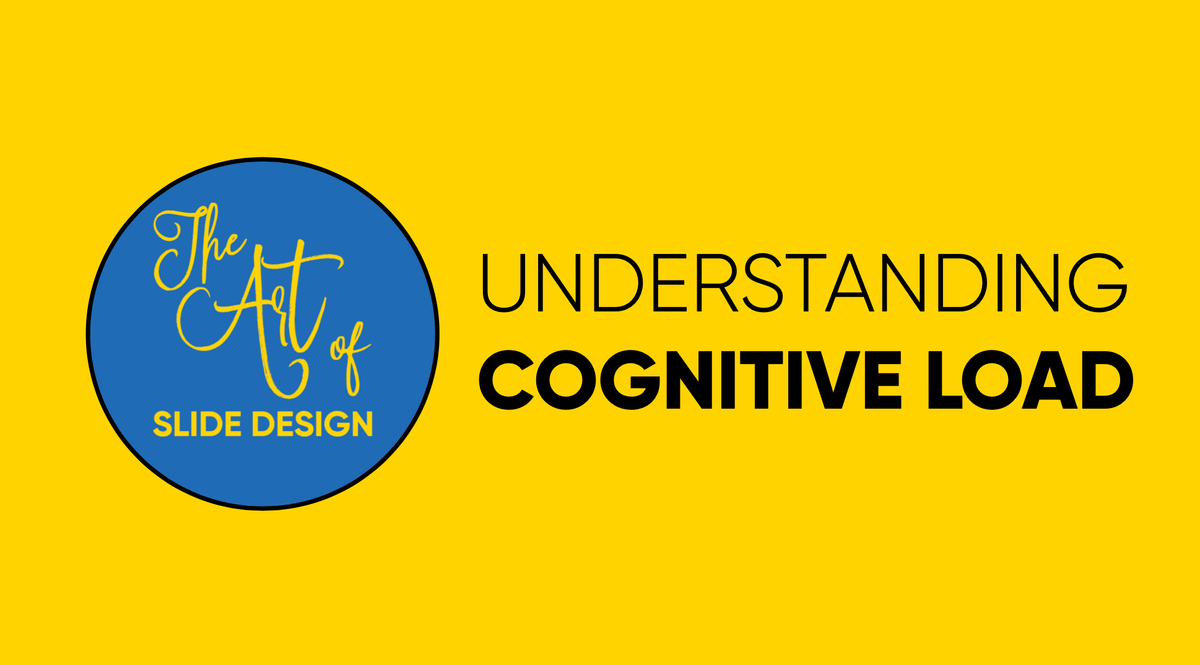The Art of Slide Design: Understanding Cognitive Load

Back in 2017, I created my first meta talk about getting better at talks: The Art of Slide Design. It was all about how to apply a couple of design principles to understand how to create more compelling slides.
When I started this new blog, I realised that not only had some of my thinking around slide design changed, but there were also other design principles and theories that I never gotten around to covering in that one talk. Rather than just lift that talk and copy-paste it here, I knew it was due a refresh. So this is the kickoff of a new recurring series: The Art of Slide Design. Follow along and subscribe to my newsletter to get regular tips on how to improve your slides.
The first few posts (like this one) will focus on some of the original content from that talk, but updated to be shinier and better! And after that, we'll focus on other design principles and how to apply those to your slides too!
For most of my life I hated giving presentations – as a kid, as a teen, as a university student. I was so scared and nervous in front of people that I tried to avoid giving them as much as I could. Whenever I did have to do one, I’d be a bunch of nerves for the entire week before, and often because of my nerves the presentation wouldn’t turn out that great. I didn’t believe it was something I’d ever be able to do well and I really didn’t believe it was something I’d ever enjoy.
Nowadays I actually like giving presentations. For the past 9 years, I’ve been giving talks at meetups and conferences, and as part of my previous roles, I've encouraged my teams to both blog and speak more.
For me, the trick of dealing with my nerves, came from being prepared.
I find that whenever I try to learn something new, it becomes easier for me if I understand all the different aspects, all the different building blocks of what it is that I’m to learn. With presentations it was about understanding my emotions and how my face and body and voice were reacting when I got nervous. It was about understanding how to tell compelling stories and how to keep the audience engaged. It was about discovering how often I need to practice until I feel completely comfortable with what I’m going to say. And it’s about understanding how to use the tools I have in the most effective way.
Alongside our voice and our words, our slides are an important instrument in our presenter’s toolbox. And we should learn to use them as effectively as we can. Just like mastering other skills, once you know some of the methods, it does get easier the more you do it.
So that’s what this series of blog posts are about: how to create effective slides.
But what does that mean? What makes your slides effective?
Let’s look at why we are presenting in the first place: what’s the goal of a presentation? At first glance you might think each presentation is different: some will be about teaching a new skill or knowledge, some will be to convince people to use a specific product, some will be to inspire and motivate people to change or do something. There are endless goals of what a presentation is for and no two presentations will be the same.
Yet at the heart of it, they all have one thing in common: no matter what your motivation behind the presentation is, your #1 goal as a presenter is to allow your audience to absorb your information. Whether you’re trying to teach, convince, motivate, frighten, sell, inspire – it’s your responsibility to make that easier for your audience.
This all ties in with the concept of cognitive load:
Cognitive load:
the amount of mental activity - perception, memory, problem solving - required to accomplish a goal.
Universal Principles of Design: Lidwell, Holden & Butler
This definition comes from the book: Universal Principles of Design and I’ll be referring to it a couple of times throughout these blog posts. It’s a great resource book covering 125 design principles and ties it back to psychology and physiology research.
Understanding cognitive load is important cause it makes us consider how much effort a certain activity will take for someone. How much information can somebody process if we present it in this format or this context? If we don't take that into account, we can cause cognitive overload: we overload the brain with too many tasks and become less effective.
So when creating our slides we need to ask ourselves: will these slides allow people to absorb our information? How much cognitive load are we asking for people to spend on this? What can we do to help reduce that cognitive load and not cause cognitive overload?
The answer lies in shifting that thinking from "how do you create effective slides" to "how do you design effective slides"?
Design should minimise cognitive load to the greatest degree possible.
Universal Principles of Design: Lidwell, Holden & Butler
When we talk about effective slides, we mean slides that help reduce that cognitive load. Slides that help rather than prevent people from consuming your information.
We can get a better understanding of slide design, by looking at design theory and understanding how we can use design principles to reduce that cognitive load. In this blog post series, I'll share various principles of slide design, so that you can create more compelling slides and help your audience absorb the information you’re presenting.
One thing to bear in mind here is that I don’t believe there is “one true way” of creating slides. This isn’t about getting you all to create the same type of slides that I do – rather it’s helping you get a basic understanding of design theory and applying it to your own style.
If you’re starting out, don’t feel like you have to attempt changing all of your slides in one go: choose one principle to apply to your next presentation and build from there. Hopefully you’ll be able to hit the ground running with some of the tips in these posts and make your slides a little bit more unique and effective.
Stay tuned for the next post: Maximise Signal, Minimise Noise.
Liked this post? Sign up to my newsletter below to get future blog posts direct in your inbox.
Interested in speaker coaching or speaker training? Get in touch with me to discuss what you’re looking for.
This blog post is part of The Art of Slide Design series:
- Part 1: Understanding Cognitive Load
- Part 2: Maximise Signal, Minimise Noise
- Part 3: Make Important Information Stand Out



